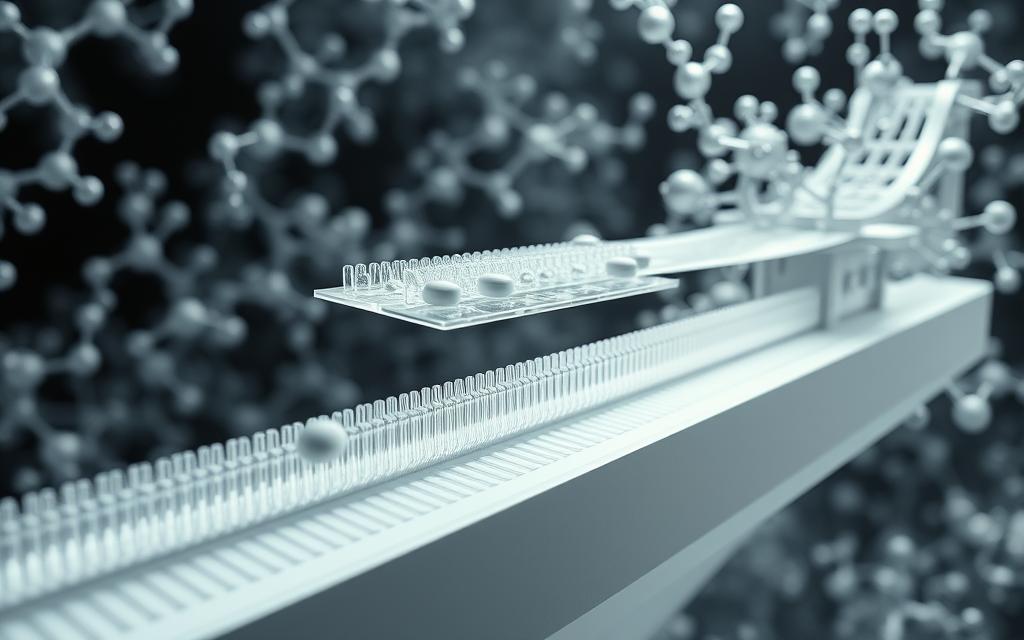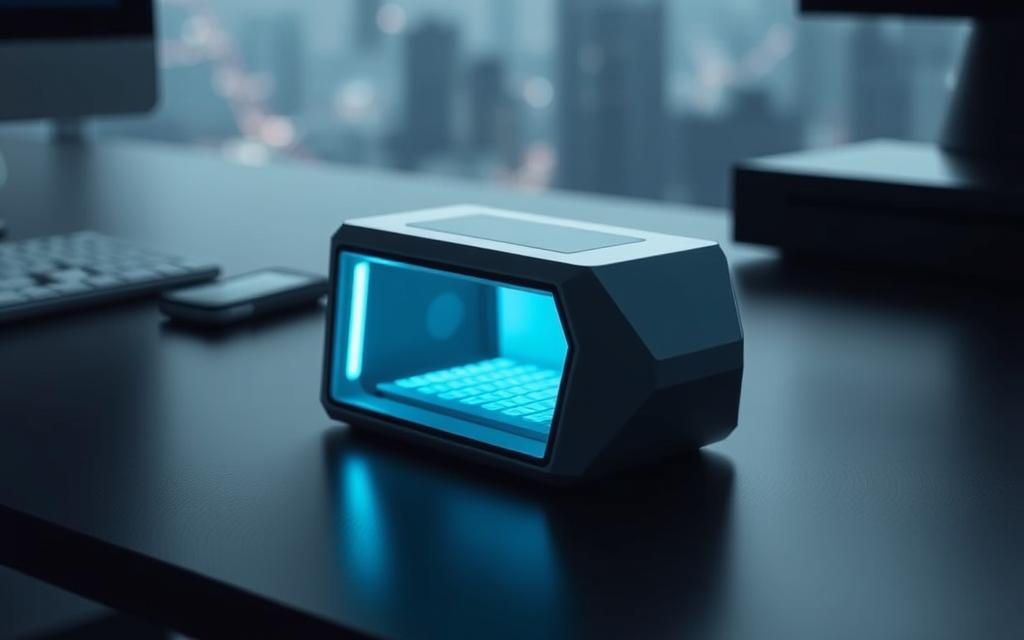Genomics has seen a big change with nanopore sequencing. This new way of looking at genes is a big step up from old methods. It gives scientists new tools to study genes.
This method works by measuring changes in ionic current as DNA or RNA goes through tiny pores. It’s a simple yet powerful way to study long DNA or RNA pieces without needing to make more copies.
Oxford Nanopore Technologies has made this tech available to labs all over the world. It lets them get long DNA or RNA sequences and find changes. This has opened up new areas in genomic research and clinical uses.
Now, scientists can get data right away while they’re sequencing. This means they can quickly understand what they’re seeing and change their plans if needed. This is really helpful in urgent situations like tracking outbreaks or making quick diagnoses.
More and more people are using this tech in research and medicine. It’s changing how we understand and use genetic information.
What Is Nanopore Technology: Core Principles and Definition
Nanopore technology is a new way to study genes. It’s different from old methods. This method lets us see DNA or RNA molecules one by one, without needing to make more copies or use special markers.
The heart of nanopore sequencing is simple. It uses a tiny hole, just a few nanometres wide. This hole can be made from proteins or created artificially, inside a special membrane.
The Science Behind Nanopore Sensing
The setup has two parts filled with electrolytic fluid, split by the membrane with the hole. When a voltage is applied, ions start moving through the hole, creating a ionic current.
This current stays steady until a DNA or RNA molecule goes through the hole. As it moves, each base changes the current in a special way. These small changes are what scientists measure and record.
This tech can spot each molecule alone by looking at these current changes. Each base – adenine, cytosine, guanine, thymine, or uracil – makes a unique pattern as it goes through.
Its main benefits are:
- It measures directly, without needing to make more DNA
- It gives data as it happens
- It can find changes in DNA naturally
- It needs very little preparation
This nanopore sensing turns biochemical info into digital data. Computers can understand this data. The signals are decoded into genetic sequences, letting scientists read long DNA or RNA stretches very efficiently.
The Mechanism of Nanopore Sequencing: A Detailed Process
Nanopore sequencing is a new way to study genes. It works through a detailed process. This method lets scientists look at DNA and RNA in great detail and quickly.

Preparation of DNA and RNA Samples
The first step is to prepare the samples carefully. This means getting the genetic material from the samples. It’s important to keep the DNA or RNA in good condition.
After getting the genetic material, it goes through library preparation. This involves several important steps:
- End repair to make the fragments blunt
- Adapter ligation to add special sequences
- Quality assessment to check the sample
This preparation is key for the next steps. The quality of the library affects how accurate the data will be.
Translocation Through the Nanopore and Signal Generation
Once the samples are ready, they go through the sequencing phase. They pass through tiny nanopores. Motor proteins, like helicases, control how fast they move.
As each nucleotide goes through the nanopore, it changes the current. These changes make electrical signals. These signals tell us what the DNA or RNA bases are.
The way signals are made is by measuring current changes. Each base type makes a unique signal. This helps identify the bases.
| Base Type | Current Disruption Pattern | Signal Strength Range |
|---|---|---|
| Adenine (A) | Moderate dip with quick recovery | 45-65 picoamperes |
| Cytosine (C) | Sharp decrease with gradual return | 35-55 picoamperes |
| Guanine (G) | Deep sustained reduction | 25-45 picoamperes |
| Thymine (T) | Brief significant drop | 40-60 picoamperes |
| Uracil (U) | Double-peak pattern | 30-50 picoamperes |
Base Calling and Data Interpretation
The last step turns the electrical signals into digital data. Algorithms look at the signals to find the DNA or RNA sequences. This process has gotten better thanks to machine learning.
Today, base calling uses neural networks to compare signals. These networks learn from past data to get better at identifying sequences.
After that, the data is put together into complete genetic sequences. Tools check the quality, fix errors, and align the sequences. This gives reliable results for research.
The whole process is a mix of biochemistry, nanotechnology, and computer science. It makes genetic analysis fast and accurate.
DNA Sequencing with Nanopore Technology
Nanopore technology has changed DNA analysis a lot. It can handle long DNA strands without breaking them. This is different from old methods.
This technology is great for complex DNA areas. It helps scientists study genetics fully.
Long-Read Sequencing for Genomic Assembly
Old methods struggle with DNA repeats and changes. Nanopore tech solves these problems with long-read sequencing.
These long reads can be millions of base pairs long. They help scientists put genomes together right. They can:
- Map DNA repeats well
- Finding changes in DNA structure
- Sort out tricky DNA areas
- Make complete genome maps
The tech also lets scientists watch the sequencing live. They can change things as they go.
Case Studies: Human Genome and Microbial Analysis
Nanopore sequencing has helped the human genome project a lot. It has filled in gaps in the genome, like at the ends.
“Long-read sequencing has changed how we study hard-to-reach parts of the human genome. It gives us new info on genes and how they work.”
During COVID-19, it helped study the SARS-CoV-2 virus fast. This helped track virus changes and helped make vaccines.
In microbial genomics, it’s been key for studying bacteria. Scientists can now make full bacterial genomes from the environment. This has given us new insights into bacteria.
| Application Area | Traditional Methods | Nanopore Sequencing | Advantage |
|---|---|---|---|
| Repetitive Region Analysis | Fragmented data | Complete coverage | Accurate assembly |
| Structural Variant Detection | Limited resolution | High precision | Better variant calling |
| De Novo Assembly | Multiple gaps | Gap-free results | Complete genomes |
| Pathogen Surveillance | Days to weeks | Hours to days | Rapid response |
Nanopore sequencing is great for urgent tasks. Health groups use it to quickly find and track pathogens.
More research places are using nanopore DNA sequencing. It’s flexible and gives detailed data, making it key for genetic studies today.
RNA Sequencing Using Nanopore Methods
Nanopore technology has changed the game in RNA analysis, just like DNA sequencing did for genomics. It lets us study RNA in its natural form. This gives us insights that were hard to get before.

Direct Detection of RNA Modifications
Nanopore sequencing lets us do direct RNA sequencing without converting RNA to cDNA. This keeps the RNA’s natural changes intact. It can spot RNA modifications as they go through the nanopore.
Some key changes it can find are:
- N6-methyladenosine (m6A)
- 5-methylcytosine (m5C)
- Pseudouridine (Ψ)
This breakthrough in epitranscriptomics lets us see how these changes affect RNA. We can learn about RNA stability, how well it’s translated, and where it goes in the cell.
Applications in Transcriptome Profiling
Nanopore RNA sequencing is great for detailed transcriptome analysis. It captures full-length transcripts. This means we can spot different versions of genes and how they’re expressed.
In cancer research, scientists use it to:
- Find new fusion transcripts
- Look at how genes are spliced differently
- See how gene expression changes in tumours
Virologists use it to study viral RNA. It can sequence viral genomes fully without needing to piece them together. This helps quickly identify new viruses.
It also lets us watch how viruses change in real-time during outbreaks.
The lack of amplification bias in direct RNA sequencing means we can measure gene expression more accurately. This is really useful for studying small changes in gene expression. It helps us understand how genes change during development and disease.
Advantages of Nanopore Sequencing Over Conventional Techniques
Nanopore sequencing is a game-changer in genetics. It offers real-time data and is super portable. This is a big leap from old methods.
Real-Time Analysis and Rapid Results
Real-time sequencing is a major win for nanopore tech. It streams data as DNA or RNA passes through pores. This is unlike old methods that wait for the whole run to finish.
This fast data flow means quicker decisions. It’s a big help in urgent cases. For example, finding pathogens in hours, not days.
It also means faster research. Scientists can tweak their experiments on the fly. No more waiting for the whole run to finish.
It’s also more straightforward. No PCR needed in many cases. This cuts down the time to get results. Labs can get genetic insights in just one day. This speeds up research and diagnosis a lot.
Portability and Field-Deployable Sequencing
Nanopore tech is tiny but mighty. Devices like the MinION are small and light. They pack a big punch in genetic analysis.
Field applications have grown a lot. Now, scientists can study DNA in hard-to-reach places. This includes remote areas and during outbreaks.
The MinION is easy to use anywhere. It runs on USB power. This means it works without a lot of setup. It’s perfect for places where big machines can’t go.
| Feature | Nanopore Sequencing | Illumina Sequencing |
|---|---|---|
| Read Length | Ultra-long reads (20kb+) | Short reads (50-300bp) |
| Portability | USB-sized devices | Benchtop instruments |
| Time to Results | Real-time streaming | Days to weeks |
| Sample Preparation | Minimal steps required | Complex library preparation |
| Modification Detection | Direct detection | Indirect inference |
Nanopore sequencing is changing genetics and diagnostics. It’s fast and portable. This opens up new ways to study genetics in places old methods can’t reach.
Challenges and Limitations of Nanopore Technology
Nanopore technology is innovative but faces some big challenges. It offers real-time analysis and can read long sequences. But, there are issues with data quality and the cost.
Understanding these problems helps labs decide if they should use this technology.

Accuracy Issues and Error Correction Methods
Nanopore sequencing often has higher error rates than other methods. It can have errors between 6-15%. In contrast, Illumina platforms are much more accurate, with errors between 0.1-1%.
These errors come from signal noise and challenges in interpreting the signals. The single-molecule nature of nanopore sequencing means there’s no built-in way to check for errors. DNA secondary structures can also affect how fast DNA moves through the pore, making it harder to understand the signals.
To improve accuracy, researchers use several strategies. One method is consensus sequencing, where the same molecule is read multiple times. This makes the results more reliable. Another approach is to combine nanopore long reads with short-read data from other platforms. New algorithms, including machine learning, are also helping to improve how accurately signals are interpreted.
Recently, new algorithms have greatly reduced error rates. These algorithms use neural networks to better understand complex signal patterns. This shows how fast error correction methods are improving in the nanopore field.
Cost and Accessibility Considerations
The cost of nanopore sequencing is a big factor for labs. The initial cost includes the sequencing device, which is a big expense. Ongoing costs include flow cells and sequencing kits, but these have gotten cheaper over time.
When looking at cost-effectiveness, several things need to be considered. The MinION device is more affordable than bigger systems. But, the cost of consumables can add up, and there are also costs for preparing samples. Nanopore protocols often need less lab work than other methods, though.
Thanks to falling costs, more labs can now use nanopore sequencing. The smaller devices are also portable, allowing for sequencing in remote areas. This opens up new possibilities for research beyond traditional labs.
As costs keep falling, nanopore technology is becoming more accessible. Consumable prices have dropped by about 40% in the last three years. There are now more affordable options for different budgets. This makes nanopore technology available to more research communities.
| Aspect | Nanopore Technology | Illumina Sequencing | Pacific Biosciences |
|---|---|---|---|
| Typical Error Rate | 6-15% | 0.1-1% | 10-15% |
| Primary Error Type | Insertion/Deletion | Substitution | Insertion/Deletion |
| Device Cost (Entry) | $1,000 | $50,000 | $350,000 |
| Cost per Gb (2023) | $20-50 | $5-20 | $40-100 |
| Error Correction Method | Consensus sequencing | Built-in redundancy | Circular consensus |
The future of nanopore technology looks bright. It needs to keep getting better at accuracy and cost. Researchers are hopeful that new developments will solve these problems. As it improves, nanopore technology will likely be used in more areas of science.
Practical Applications and Future Prospects
Nanopore sequencing technology has moved beyond research labs. It now changes healthcare and scientific discovery. This technology makes breakthroughs in many areas, from quick disease diagnosis to environmental monitoring.

Clinical Uses: Pathogen Detection and Cancer Genomics
In clinical diagnostics, nanopore sequencing is fast. It can spot infectious agents quickly. This is vital in sepsis cases or during outbreaks.
The tech is great for cancer genomics too. It finds complex genetic changes. This helps in making treatments that fit each person’s cancer better.
Some key uses are:
- Monitoring antimicrobial resistance in real-time
- Finding rare cancer variants with long-read sequencing
- Studying RNA changes in tumours
- Quickly spotting outbreak strains
Innovations in Portable Sequencing Devices
The world of portable sequencing innovations is growing fast. Devices have gone from big machines to small, handheld ones. This makes sequencing possible in many places, like remote clinics or disaster zones.
Future plans include combining microfluidics with nanopore tech. This will make lab-on-chip systems that do everything automatically. Soon, we might have devices that watch health markers or track pathogens in real time.
These tools are not just for humans. They’re also used in agriculture and forensics. Scientists use them to find plant diseases or solve crimes. The tech is getting better and cheaper, opening up more uses.
Adding artificial intelligence to nanopore data analysis will bring even more progress. AI helps make the tech more accurate and efficient. This mix of hardware and software will make the tech more widely used in science and medicine.
Conclusion
Nanopore sequencing is changing how we study DNA and RNA. It allows for real-time, long-read sequencing that’s easy to move around. This makes it great for research in labs and out in the field.
This method can look at whole transcripts and find changes directly. It’s a big step up from older technologies. Oxford Nanopore Technologies has made devices for quick sequencing. These are used for checking pathogens and monitoring the environment.
Even though it’s not perfect yet, it’s getting better. New ways to fix mistakes and improve computer methods are helping. This means nanopore sequencing could be used more in hospitals for cancer and disease diagnosis.
The future of DNA and RNA studies will rely on nanopore technology. As it gets better and cheaper, it will help us learn more about life. It will be key in many scientific areas, leading to new discoveries.







